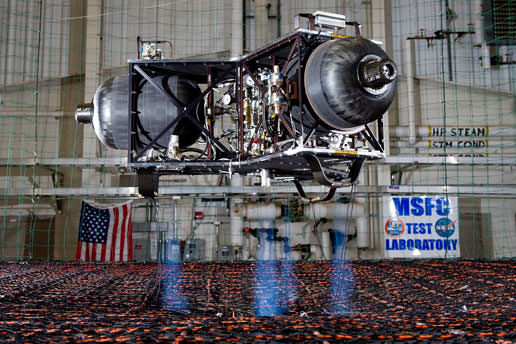[/caption]
The best way to study the new-found water on the Moon would be with in-situ instruments. Since humans won’t be making any lunar landings for at least a decade, the next best option is robotic spacecraft. NASA’s Marshall Space Flight Center is developing and testing a new robotic lander to explore not only the Moon, but also asteroids and Mars. This design is definitely next generation: it’s bigger than any lander yet and MSFC is currently testing the all-important final of reaching the destination: landing.
“Specifically, what we are doing at Marshall is identifying the terminal – or the final – phase of landing, and designing a robotic lander to meet those needs,” said Brian Mulac, a test engineer at Marshall, quoted in an article in the Huntsville Times. “That last part is the highest risk of setting down on the moon.”
Of course, parachutes can’t be used for landing on the Moon or asteroids, since neither destination has an atmosphere, so thrusters are key for landing.
Large, oval-shaped tanks on the craft are used to store fuel for thrusters. Thrusters guide the lander, controlling the vehicle’s altitude and speed for landing. An additional thruster on this test vehicle, above, offsets the effect of Earth’s gravity so that the other thrusters can operate as they would in a lunar environment.
Just in case the tests don’t go as planned, a huge net is place under the lander to catch the vehicle and avoid damaging it.
As the saying goes, it’s not the fall that’s dangerous, but the sudden stop.
Landing on Mars requires a different architecture, such as the Mars Science Laboratory’s sky-crane, because of the pesky, thin atmosphere on the Red Planet. Read our previous article with Rob Manning of JPL about the issues of landing large payloads on Mars.
Sources: Huntsville Times, Gizmodo

